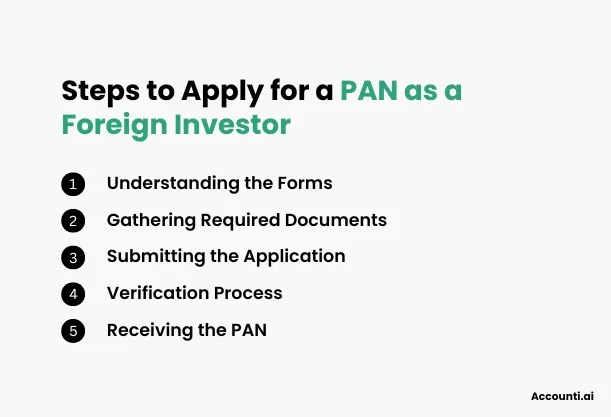
5 Step PAN Application Process for Foreign Investors
Table Of Content
Investing in India is an attractive option for foreign investors due to the country's growing economy and vast market opportunities. However, before a foreign investor can fully engage in business activities or participate in the financial ecosystem of India, obtaining a Permanent Account Number (PAN) is essential. The PAN is a unique identification number issued by the Indian Income Tax Department, used for tracking tax payments, filing returns, and conducting business transactions.
But what exactly is the PAN application process for foreign investors, and how can one ensure it's done smoothly? In this guide, we’ll break down the steps, eligibility, and essential details you need to know to obtain a PAN in India as a foreign investor.
Why Foreign Investors Need a PAN
Foreign investors must obtain a PAN to comply with Indian tax laws. A PAN is often required for transactions like setting up a Demat account, which is necessary for holding shares in India. For more detailed guidance on Demat account setup, you can refer to India Demat Account Setup, which outlines the process for foreign investors.
- Complying with tax regulations: The PAN is necessary for paying taxes on income earned in India.
- Opening bank accounts: Most financial institutions in India require a PAN to open accounts.
- Facilitating investments: Whether you're investing in mutual funds, the stock market, or real estate, the PAN is often mandatory for transactions.
Having a PAN also helps in simplifying tax returns and avoiding penalties. Essentially, it serves as a legal bridge for foreign investors to conduct business in India without unnecessary regulatory hiccups.
Eligibility Criteria for Foreign Investors
So, who qualifies for a PAN as a foreign investor? Here are the general eligibility criteria:
- Foreign individuals who plan to invest or earn income in India.
- Foreign companies or entities engaging in business or financial transactions.
- Foreign institutional investors (FIIs) or foreign portfolio investors (FPIs) dealing in the Indian stock market.
In short, any individual or organization looking to invest or conduct financial activities in India will likely need a PAN.
Steps to Apply for a PAN as a Foreign Investor

Step 1: Understanding the Forms
Foreign investors must use Form 49AA for PAN application. This form is specifically designed for non-resident entities or individuals. You can easily download it from the NSDL (National Securities Depository Limited) or UTIITSL websites, the two authorized entities for processing PAN applications in India.
Step 2: Gathering Required Documents
Depending on whether the applicant is an individual or an entity, the required documents can differ. Below is a list of general documents that are commonly needed:
For foreign individuals:
- Proof of identity (passport or overseas citizenship card)
- Proof of address (utility bill, bank statement)
- Date of birth proof (passport, birth certificate)
For foreign entities:
- Certificate of incorporation
- Registration certificate from a foreign regulatory body
- Proof of address (a recent utility bill or bank statement of the company)
Step 3: Submitting the Application
Foreign investors can submit the PAN application either online or offline:
- Online Application: You can apply through the NSDL or UTIITSL websites. After completing Form 49AA, upload the required documents and pay the processing fee online.
- Offline Application: Download the form, fill it out, attach the necessary documents, and send it to the designated NSDL or UTIITSL offices in India.
Once submitted, you will receive an acknowledgment number, which can be used to track the status of your application.
Step 4: Verification Process
After submitting the application, your documents will be verified by the Income Tax Department. Verification is usually straightforward but may take longer if documents are unclear or not properly attested. For foreign applicants, it is crucial that all documents are either notarized or apostilled, depending on the applicant’s country of residence.
Step 5: Receiving the PAN
Once the verification is complete, the PAN card is generated. Foreign applicants can receive their PAN card via the address provided or can opt for an e-PAN (in PDF format), which is just as valid for most transactions. Typically, it takes around 15 to 20 days to receive the physical card, though timelines can vary based on location and document verification.
Common Issues and How to Avoid Them
There are a few common problems that foreign investors might encounter when applying for a PAN:
- Mistakes in Form 49AA: Small errors like misspelling names or providing incorrect addresses can delay your application.
- Incorrect documentation: Ensure all submitted documents are valid, correctly attested, and properly formatted as per Indian legal requirements.
- Delays in submission: Processing delays often happen if forms are incomplete or documents are missing.
By being meticulous during the application process, you can avoid these setbacks and speed up your approval.
Benefits of Holding a PAN for Foreign Investors
Holding a PAN comes with numerous advantages for foreign investors:
- Compliance with tax laws: With a PAN, paying taxes and complying with Indian regulations becomes straightforward.
- Ease of transactions: From opening bank accounts to conducting investments, the PAN is a gateway to smoother financial transactions in India.
- Faster regulatory clearances: Many Indian government departments require PAN details to process applications and clearances.
Comparison Between PAN Application for Foreigners and Indian Residents
|
Criteria |
Foreign Investors |
Indian Residents |
|
Application Form |
Form 49AA |
Form 49A |
|
Required Documents |
Foreign identity and address proof |
Indian identity and address proof |
|
Processing Time |
15-20 days (approx.) |
7-15 days (approx.) |
|
Submission Process |
Online/Offline with notarized docs |
Online/Offline |
|
Receiving PAN |
Physical PAN or e-PAN |
Physical PAN or e-PAN |
Conclusion
Applying for a PAN as a foreign investor may seem like a lengthy process, but with the right documentation and attention to detail, it can be completed smoothly. Whether you’re an individual looking to invest in India’s booming markets or a company expanding operations, the PAN is an essential step to ensure compliance with Indian tax laws and facilitate your transactions.

 Rohit Kapoor
Rohit Kapoor

